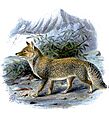Tibetan fox facts for kids
Quick facts for kids Tibetan fox |
|
|---|---|
 |
|
| Conservation status | |
| Scientific classification | |
| Genus: |
Vulpes
|
| Species: |
ferrilata
|
 |
|
| Tibetan fox range | |
| Synonyms | |
|
Vulpes ekloni (Przewalski, 1883) |
|
The Tibetan fox (Vulpes ferrilata), also called the Tibetan sand fox, is a type of true fox. It lives only in the high Tibetan Plateau region. You can find it in places like Ladakh, Nepal, China, Sikkim, and Bhutan. These foxes live in very high places, sometimes as high as 5,300 meters (about 17,400 feet) above sea level!
Contents
What Does It Look Like?
The Tibetan fox is a small fox with a strong, compact body. It has soft, thick fur that helps it stay warm. Its nose is quite narrow, and it has a bushy tail.
The fur on its face, head, neck, back, and lower legs is usually a tan or reddish-brown color. Its cheeks, sides, upper legs, and rear are grey. The tip of its tail is white. Its short ears are tan or greyish-tan on the back, but white inside.
Adult Tibetan foxes are about 60 to 70 centimeters (24 to 28 inches) long, not counting their tail. Their tails add another 29 to 40 centimeters (11 to 16 inches) to their length. These foxes usually weigh between 4 and 5.5 kilograms (9 to 12 pounds).
Where Do They Live?
The Tibetan fox lives only on the Tibetan Plateau in western China and the Ladakh plateau in northern India. You can find them north of the Himalayas mountains. This includes parts of Nepal, India, Tibet, and Chinese provinces like Qinghai, Gansu, Xinjiang, Yunnan, and Sichuan.
These foxes prefer to live in dry or semi-dry grasslands. They like open areas, far away from people or thick plants. They live in high plains and hills, usually between 3,500 and 5,200 meters (11,500 to 17,000 feet) high. Sometimes, they are seen at lower elevations, around 2,500 meters (8,200 feet).
What Do They Eat?
Tibetan foxes mainly hunt and eat Plateau pikas. Pikas are small, rabbit-like animals. Besides pikas, they also eat other small animals like rodents, marmots, woolly hares, and lizards. They are also scavengers, meaning they will eat the remains of animals that have already died. This can include Tibetan antelopes, musk deer, blue sheep, and farm animals.
Tibetan foxes usually hunt alone during the day. This is because their favorite food, pikas, are also active during the day.
Sometimes, Tibetan foxes even hunt with brown bears! The bears dig for pikas, and if a pika tries to escape the bear, the fox might catch it instead. It's like a team effort!
Family Life
Tibetan fox pairs often stay together and may even hunt together. After a mother fox is pregnant for about 50 to 60 days, she gives birth to two to four young foxes. These baby foxes are born in a den.
The young foxes stay with their parents until they are about eight to ten months old. Their dens are usually built at the bottom of large rocks, or on low slopes. A fox den can have up to four entrances, each about 25 to 35 centimeters (10 to 14 inches) wide.
In Culture
A famous photograph of a Himalayan marmot being attacked by a Tibetan fox won first prize in the 2019 Wildlife Photographer of the Year award.
Images for kids
See also
 In Spanish: Zorro tibetano para niños
In Spanish: Zorro tibetano para niños




